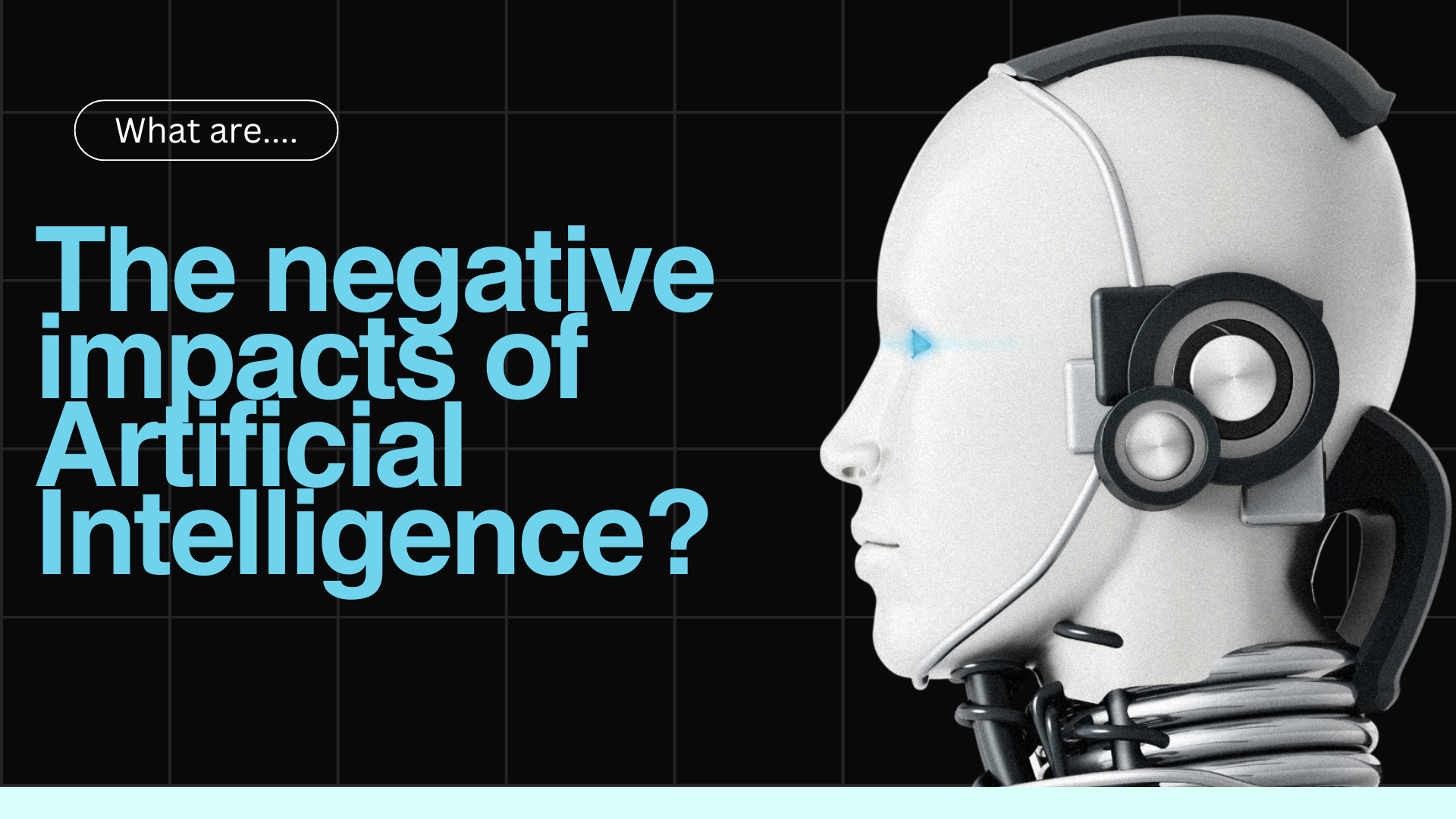
Artificial intelligence (AI) offers numerous benefits and will continue to enhance our modern world. However, it also brings potential negative consequences. Addressing these concerns early on will help us better manage and mitigate the associated risks.
Context
Artificial intelligence (AI) offers many benefits, including increased productivity and innovative problem-solving. However, it also presents several challenges. Automation can result in job losses as machines take over tasks previously done by humans. Privacy concerns arise because AI systems often require large amounts of data, which can be susceptible to misuse. Additionally, AI algorithms might unintentionally reinforce existing biases, affecting fairness in areas like employment and law enforcement. To fully realize AI’s advantages while mitigating its potential drawbacks, it is crucial to address these negative impacts effectively.
What is the negative impact of AI on human loss in decision?

In fact, AI technologies and applications offer numerous benefits, but they also come with significant drawbacks. One major issue is the diminishing role of humans in decision-making processes. As AI continues to advance, it increasingly takes over tasks that were once managed by human intuition, critical thinking, and creativity. This gradual shift threatens to erode these valuable mental skills over time, reinforcing the idea that if we don’t use these abilities, we risk losing them. The rapid adoption of AI is apparent, with its involvement in strategic decision-making rising from 10% to 80% in just five years.
What are the negative effects of artificial intelligence on the economy?
Artificial Intelligence (AI) has the potential to significantly impact the economy, and while there are many positive effects, there are also several potential negative consequences. Here are some key concerns:
1. Job Losses:
AI can take over tasks done by humans, which might lead to people losing their jobs, especially in fields with repetitive tasks.
2. Lower Wages:
With more automation, there could be fewer jobs available, which might drive wages down as more people compete for the same positions.
3. Widening Wealth Gap:
The people and companies that develop AI might get richer, while others might struggle, increasing the gap between the wealthy and everyone else.
4. Skill Mismatches:
As AI advances, workers might need new skills to keep up. Those who can’t get training might find it hard to stay employed.
5. Industry Changes:
Traditional businesses might have trouble competing with AI-driven companies, leading to instability in some sectors.
6. Fewer Competitors:
Big companies with advanced AI might become too dominant, reducing competition and making it harder for new or smaller businesses to succeed.
7. Privacy and Security Risks:
AI can be misused for things like surveillance or hacking, which raises concerns about privacy and security.
8. Over-dependence:
Relying too much on AI could make industries vulnerable if AI systems fail or are disrupted.
To address these issues, we need smart policies, better education and training, and fair practices to ensure everyone benefits from AI advancements.
What are the negative effects of artificial intelligence on employment?
AI’s rapid development, while transformative, also raises significant concerns about its impact on employment. Key challenges include:
Job Displacement:
AI-driven automation may render certain roles obsolete, particularly those involving routine tasks. This can lead to job losses in sectors like manufacturing and clerical work.
Economic Inequality:
AI’s effects on employment can exacerbate economic inequality. While skilled workers may thrive, low-skilled workers facing job loss may struggle to adapt, widening the gap between rich and poor.
Skill Mismatch:
The rise of AI technologies demands new skills, creating a risk that displaced workers may not possess the qualifications needed for emerging roles, leading to unemployment or underemployment.
Ethical Concerns:
AI’s decision-making autonomy raises ethical issues about accountability and bias. Algorithmic bias or unethical use could undermine trust in AI systems and limit their potential to create job opportunities.
How can AI negatively affect the environment?
While AI offers crucial benefits in addressing climate change, it can also have negative environmental impacts, such as contributing to increased electronic waste.Here are several ways AI could negatively impact the environment
1. Electronic Waste:
The deployment of AI systems typically requires a significant amount of technology and computing power. As these systems reach the end of their life cycle, they could generate more electronic waste compared to older computer systems, potentially leading to increased environmental pollution.
2. Excess Energy Consumption:
AI systems, especially large-scale models, demand substantial energy to operate, often continuously. This increased energy usage can lead to higher carbon emissions, particularly if the energy is not sourced from renewable resources.
3. Reduced Incentive for Action:
While AI can assist in developing climate strategies, it cannot implement them on its own. Excessive reliance on AI for generating ideas might lead to a lack of coherent action plans, potentially stalling effective environmental initiatives.
4. Strain on Energy Grids:
The growing demand for AI technology can put additional pressure on our electricity grids. As we move away from fossil fuels, the increased energy needs for AI could exacerbate shortages and affect the availability of electricity for other uses.
5. Data Storage Requirements:
AI relies on substantial data storage, which comes with its own carbon footprint. The energy needed to maintain and cool data storage facilities can contribute to environmental impact.
6. Potential Miscalculations:
AI lacks human judgment and may miscalculate important factors, such as the impact of natural disasters. This could result in inadequate resource allocation for affected communities, exacerbating the consequences of such events.
In summary, while AI can be a valuable tool in advancing climate goals, it is essential to consider its environmental impacts and use it judiciously to mitigate potential negative effects.
What are the negative impacts of AI in government?
AI in government can bring significant benefits, such as improved efficiency and data-driven decision-making. However, there are also several potential negative impacts to consider:
1. Privacy Concerns:
AI systems often require large amounts of data, including personal information. This can lead to concerns about privacy and data security, especially if data is mishandled or if there’s inadequate protection against unauthorized access.
2. Bias and Discrimination:
AI algorithms can inadvertently reinforce existing biases in the data they are trained on. This can lead to unfair treatment of individuals or groups, particularly in sensitive areas like law enforcement or social services.
3. Lack of Transparency:
Many AI systems, especially those using deep learning, operate as “black boxes,” making it difficult to understand how they reach their conclusions. This lack of transparency can undermine public trust and accountability in government decisions.
4. Job Displacement:
Automation and AI can lead to the displacement of government workers, as certain tasks become automated. This can create challenges for employees who need to transition to new roles or acquire new skills.
5. Security Risks:
AI systems can be vulnerable to hacking or manipulation, which could have serious implications for national security or the integrity of public services.
6. Over-reliance on Technology:
Relying too heavily on AI for decision-making can reduce human oversight and critical thinking. This can be particularly problematic in complex or nuanced situations where human judgment is crucial.
7. Ethical Concerns:
The deployment of AI in areas like surveillance or law enforcement raises ethical questions about civil liberties and the potential for misuse. Ensuring that AI is used in a way that respects human rights and ethical standards is crucial.
8. Cost and Resource Allocation:
Developing and implementing AI systems can be expensive. Governments need to balance these costs with other priorities and ensure that resources are allocated effectively.
9. Inequality:
There’s a risk that the benefits of AI might be unevenly distributed, leading to increased inequality. For instance, more affluent areas might have better access to advanced AI technologies compared to underserved regions.
10. Complexity and Understanding:
Policymakers may struggle to understand the technical complexities of AI, which can hinder effective regulation and oversight. Ensuring that decision-makers are well-informed about AI is essential for responsible governance.
Addressing these issues requires careful planning, robust regulation, and ongoing oversight to ensure that AI is used in ways that maximize its benefits while minimizing potential harms.
Conclusion:
In conclusion, while AI holds immense potential for advancing efficiency and innovation, its negative impacts such as privacy concerns, bias, and security risks must be carefully managed. Addressing these challenges requires a proactive approach, including transparent policies, robust oversight, and ongoing ethical considerations. Balancing the benefits and drawbacks of AI will be crucial for ensuring that its integration into government enhances rather than undermines public trust and equity.





